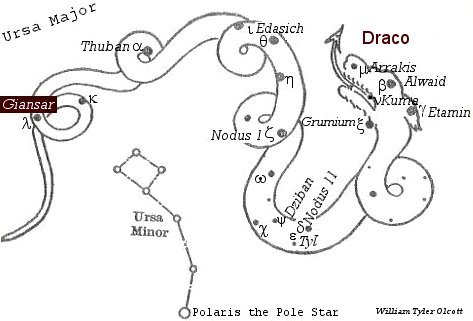| Fixed star: GIANSAR Gianfer, Gianfar | |
| Constellation: lambda (λ) Draco | |
| Longitude 1900: 08LEO55 | Longitude 2000: 10LEO20 |
| Declination 1900: +69.53′ | Declination 2000: +69.20′ |
| Right ascension: 11h 31m | Latitude: +57.14′ |
| Spectral class: M0 | Magnitude: 4.1 |
The history of the star: Giansar
from p.210 of Star Names, Richard Hinckley Allen, 1889.
[A scanned copy can be viewed on this webpage
Lambda (λ) Draco, Giansar, is a small orange star in the Dragon’s tail.

![]() is the head, and the south node
is the head, and the south node ![]() is the tail, i.e. the moon’s nodes]. This singular idea descended into comparatively modern times, and, although these points are far {p.211} removed from Draco, still obtains in the name for lambda (λ this star Giansar). Juza is another popular title.
is the tail, i.e. the moon’s nodes]. This singular idea descended into comparatively modern times, and, although these points are far {p.211} removed from Draco, still obtains in the name for lambda (λ this star Giansar). Juza is another popular title.
It also has been known as Nodus secundus, the Second Knot, possibly because thus located on some drawings; yet it is far removed from delta (δ Nodus 11), which usually bears that name.
In China it was Shang Poo, or Shaou Poo
Although the last lettered star in the figure of the constellation Draco, it lies at a considerable distance from the end, as figured on the atlases of Heis and Argelander.
Star Names, Their Lore and Meaning, Richard Hinckley Allen, 1889].
“Hebrew name Giansar, ‘the punished enemy'”. (Bullinger The Witness of the Stars ).
The astrological influences of the constellation Draco
Legend: Draco represents the dragon that guarded the golden apples in the garden of the Hesperides. According to other accounts, however, it is either the dragon thrown by the giants at Minerva in their war with the Gods, or the serpent Python slain by Apollo after the deluge. [Robson, p.43.]
Influences: According to Ptolemy the bright stars are like Saturn and Mars. Draco gives an artistic and emotional but somber nature, a penetrating and analytical mind, much travel and many friends but danger of robbery and of accidental poisoning. It was said by the Ancients that when a comet was here poison was scattered over the world. By the Kabalists it is associated with the Hebrew letter Mem and the 13th Tarot Trump “Death.” [Robson, p.43.]
References:
Fixed Stars and Constellations in Astrology, Vivian E. Robson, 1923].